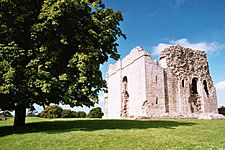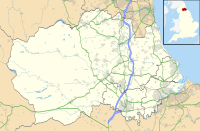Bowes Castle facts for kids
Quick facts for kids Bowes Castle |
|
|---|---|
| Bowes, County Durham, England | |

Keep of Bowes Castle
|
|
| Coordinates | 54°31′00″N 2°00′50″W / 54.5168°N 2.0139°W |
| Site information | |
| Owner | English Heritage |
| Open to the public |
Yes |
| Site history | |
| Materials | Stone |
| Events | Great Revolt of 1173–74 |
Bowes Castle is an old castle found in the village of Bowes, in County Durham, England. It was built inside the walls of an even older Roman fort called Lavatrae. This fort was right next to a Roman road, which is now the A66.
At first, there was a wooden castle here. But between 1170 and 1174, King Henry II ordered a much stronger stone castle to be built. A planned village grew up next to the castle.
Bowes Castle survived attacks from Scotland during a big uprising in 1173–74. However, rebels managed to raid it in 1322. Over time, the castle fell into disrepair. Much of it was taken apart after the English Civil War. Today, the ruins are owned by English Heritage. You can visit them for free during the day.
Contents
History of Bowes Castle
Early Days: Roman Fort to Timber Castle
Bowes Castle was built within the remains of an old Roman fort called Lavatrae. This area was very important because it was one of the few easy routes between England and Scotland. It remained a key spot for many years.
The land where the castle stands was owned by the King. Around 1136, a leader named Alan de Bretagne built a wooden castle here. It was in the corner of the old Roman fort. Other castles nearby, like Brough and Brougham, also used old Roman fort sites.
Alan's son, Conan, inherited the castle. When Conan died in 1171, King Henry II took control of it.
King Henry II's Stone Castle
King Henry II was worried about safety in the north. So, he spent a lot of money building a new, strong stone castle at Bowes. This happened between 1171 and 1174. It was unusual to build a new royal castle here at that time.
Henry II was likely worried about attacks from Scotland. This was especially true during the Great Revolt of 1173 to 1174. He spent almost £600 on the castle. Most of this money was spent in the first few years. Local leaders helped oversee the building work.
The new castle had a special type of main tower called a hall-keep. This was not a common design in English castles. It was made of stone and had three floors. The tower was about 82 feet (25 meters) long, 60 feet (18 meters) wide, and 50 feet (15 meters) high.
Inside, the keep had a long hall and a private room called a solar. It had large, round windows. The keep looked similar to other castles nearby, like Middleham and Outhgill.
A ditch created an inner defensive area around the keep. The old Roman fort walls formed a larger outer area. A mill was built by the River Greta. This mill made flour for the castle's soldiers.
The village of Bowes was built after the castle. It was a planned village that led up to the castle. It had a church and a market place. This kind of planned village was also unusual in England.
The Great Revolt and Scottish Attacks
In England, a big uprising against King Henry's rule began. Rebellious lords joined forces with the King of Scots and other European allies. King William the Lion of Scotland moved south in 1173. Bowes Castle was damaged during these attacks.
Workers made repairs to the castle, including the rooms and gates. They also built defenses around the keep. This was in case of more attacks the next year. In 1174, William, King of Scots, directly attacked the castle. But he had to leave when King Henry's son, Geoffrey, arrived with help.
Later Years and Decline
King Henry II stopped the Great Revolt. He captured William the Lion and made a peace treaty. This treaty gave Henry more power in Scotland. After this, the north of England became much safer.
In 1203, King John gave control of Bowes Castle to Robert de Vieuxpont. Robert was an important leader in the north. He kept control until 1228. King John himself stayed at the castle in 1206 and 1212. The castle also briefly held King John's niece, Eleanor of Brittany.
Later, the castle was given to different lords. It stayed with the Earls of Richmond until 1322. By then, it was in poor condition. King Edward II then gave Bowes Castle to John de Scargill. But local people who supported the Earl of Richmond rebelled. They attacked the castle.
The castle's lord was away at the time. The attackers burned part of a hall. They drank a lot of wine and stole armor and other items. More fighting with Scotland led to more raids on the castle and the land around it. Fields were left empty. By 1340, the castle was in ruins.
Modern History
The ruined Bowes Castle was taken back by the Crown in 1361. From 1444 to 1471, the powerful Neville family owned it. Then it went back to the Crown again.
King James I sold the castle in the early 1600s. Most of the remaining defenses were taken apart in the mid-1600s. This happened after the English Civil War.
By 1928, the castle was in bad shape. Not many people were interested in it. The owner, Lady Lorna Curzon-Howe, faced taxes on her estate. So, in 1931, she agreed to give the castle to the Office of Works.
Today, English Heritage looks after Bowes Castle. It is a place where tourists can visit. The main tower, or keep, is still mostly standing. It is a protected historic building.
Images for kids







